Searching for traces of lost Jewish life
The Cologne-based photographer and blogger Christian Herrmann has travelled Eastern Europe for years to document traces of Jewish life before the Holocaust. Here, in a belt between the Baltic and Black Seas, lived the majority of European Jews. During the Second World War, almost all of them were murdered by the German occupiers and their collaborators. What remains are traces of Jewish life: destroyed or misappropriated synagogues, overgrown cemeteries, tombstones in the street paving, and traces of home blessings on door jambs. His book In schwindendem Licht / In Fading Light presents 110 photos of Jewish heritage sites in 57 cities, towns and villages in Ukraine, the Republic of Moldova, Poland, Hungary and Romania. We’ve asked him some question about his photographs by e-mail.
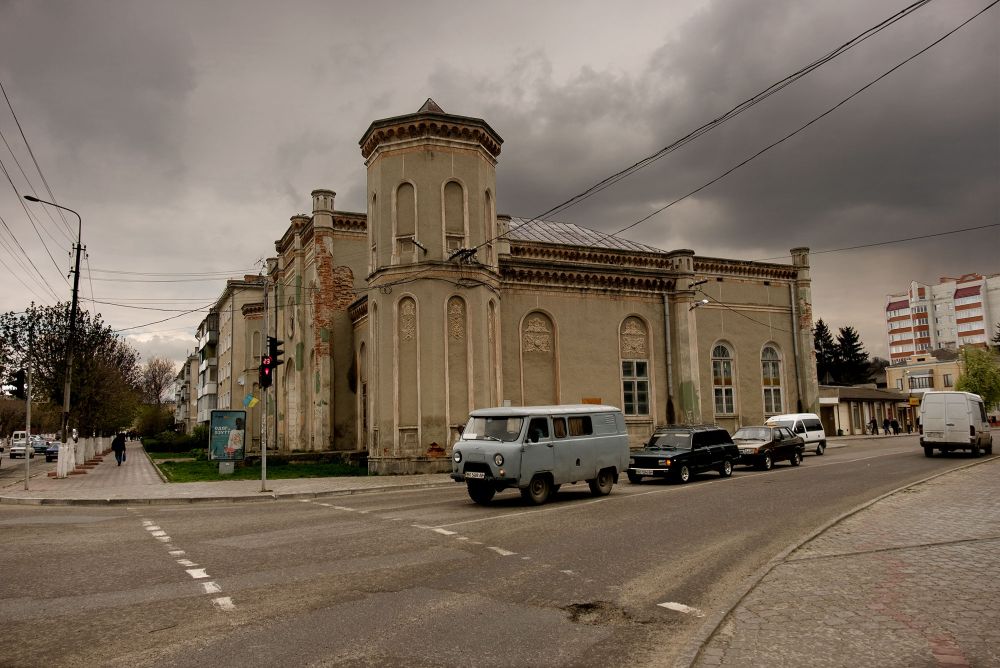 Chortkiv, Galicia, Ukraine. Synagogue. Photo: Christian Herrmann
Chortkiv, Galicia, Ukraine. Synagogue. Photo: Christian Herrmann
Your weblog Vanished World and your book 'In Fading Light' reveals you have visited a lot of locations and countries during the past ten years. When did you first encounter traces of lost Jewish life in Eastern Europe and why did you decide to document it by photography?
In the second half of the 1990s, I was invited to a summer academy near Krakow. I was blown away by the beauty of Krakow and wondered why Western Europeans did not travel to Eastern Europe - now that the borders were open. In Krakow, one inevitably stumbles upon the city's Jewish history. And that was my next question: Why don't I know anything about it? Since then, the topic of traces of Jewish life has been on my agenda. So I started travelling and taking photographs. At some point I realised that friends and colleagues were curious about what I found there. So I systematised my travels and made the pictures public. In fact, more people are interested in them than I originally thought.
How do you prepare your travels? Do you know beforehand where you want to go and take photos of or are often surprised?
That has changed a lot over the years. In the beginning, I looked for places where I assumed that something could be found there. There I had to ask around with the locals. That was not always easy, because these are often places where the population was almost completely replaced after the Holocaust and by forced resettlements after the Second World War. Young people often don't know that the local cinema was once a synagogue or that the city park was a Jewish cemetery.
Meanwhile, there are good sources on the internet and I can plan trips very precisely and know what I will find on the spot in advance. But because I also often travel with friends from the areas I explore, I am sometimes lucky enough to find traces that have not yet been documented. I benefit from their knowledge.
Most of the photos in your book seems to be taken during autumn or winter. This gives them a gloomy atmosphere, which is compatible with the sad subject of the photos. Is this on purpose and what are your feelings while visiting locations like deserted grave yards and ruins of synagogues? How do you make sure you don't get depressed?
Yes, my travel times are intentional. I travel in autumn, winter and spring - not in summer. I don't like my pictures to look like it's time to go to the beach now.
Not every place is depressing. There are very beautiful cemeteries. You can sit there, listen to the birds and feel the passing of time. I feel then that there is something bigger than us individual human beings. I don't have a name for it, but it is something that teaches us humility. And that can be a very beautiful experience. I think everyone knows the feeling of lying on your back at night and looking up at the starry sky. It's a very similar experience.
Of course, many places are just depressing and leave me with abysmal sadness. It is therefore important for me to travel with friends who share my interests and with whom I can talk about the daily experiences in the evening. The people who follow my travels online are also a great support. Often they were born where I am photographing, or their families originate from there. They share their memories or those of their families and I can give them something by showing them what it looks like there today. These contacts are very important to me.
The title of your blog is a tribute to photography pioneer Roman Vishniac. Could you tell us who he was and why does he inspire you?
Roman Vishniac was a giant, I really don't want to compare myself to him. He was one of the last to photograph Jewish life from Berlin to Galicia - before it was destroyed by the Germans and their helpers. Of course, he could not have known this in the second half of the 1930s, at best he could have suspected or feared it. He was not the only photographer to whom we owe pictures from that time, but he was perhaps the most talented and he had a feeling for people. His portraits are unique. Like him, we live in a time of upheaval, things change quickly and some disappear irretrievably. I photographed a former Jewish study house in Burschtyn in Ukraine several times. It has since been demolished. Like this study house, traces disappear day by day. They are the traces of the people whose portraits Vishniac left us. That is the reason why my pictures are mostly deserted.
Of course, there are the other examples: Synagogues that have been restored and cemeteries that are maintained by local or international initiatives. I don't want to give the impression that everything will disappear, because that would not be true. But not everything will be saved either.
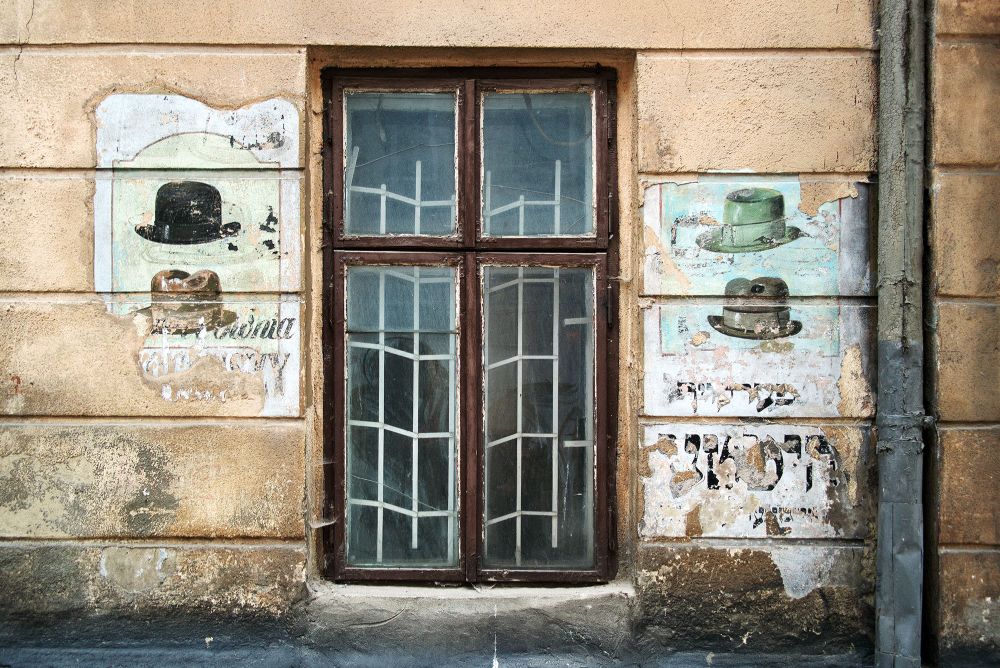 Lviv, Galicia, Ukraine, 2015. Shop sign of an Jewish hatter. Photo: Christian Herrmann
Lviv, Galicia, Ukraine, 2015. Shop sign of an Jewish hatter. Photo: Christian Herrmann
Below the photos in your book is only a brief caption with the location and the date. “I have nothing to say. Just to show”, so you quote the German philosopher Walter Benjamin (1892-1940). Do you think the readers of your book will understand the historical meaning of your photos without knowing the underlying facts?
There is a reason why I asked my friend Adam Kerpel-Fronius to write a foreword. He is a historian and works at the Memorial to the Murdered Jews of Europe in Berlin. Of course, the images need a historical context. The image of an empty field remains the image of an empty field as long as you don't know that there is a mass grave underneath. What I wanted to say with the quote is this: Memory and commemoration is something very personal and I don't want to tell people what to think and feel. The reactions to my pictures are diverse: anger, sadness, disgust, shock, joy that there are still traces. A lot of it is very emotional. Some people don't want to see the pictures because it reminds them of how and where their relatives were murdered. All these reactions have their reasons and it is not for me to judge which feelings are right or wrong. There is no right or wrong here.
I also hope that my pictures contribute to what and how we remember. Almost always, when something about the Holocaust is published in a newspaper or an online magazine, the editors choose the same motif to illustrate it: the tracks leading through the gate of Auschwitz-Birkenau into the camp. Anyone who has ever been there has certainly seen the many people who photograph this motif themselves. They replicate the image that is already in their head. Our world of images is becoming impoverished and with it our knowledge about the Holocaust. Of course, we must remember what happened in Auschwitz. However, most of the victims never saw a camp from the inside. They were shot in pits, ditches or quarries in the immediate vicinity of their homes, or they were taken to places that are poorly described by the term camp, because they were pure killing facilities. Most people have never heard of these place but they are essential for a comprehensive understanding of the Holocaust. We need other and more images in the collective memory so that our knowledge does not become impoverished.
In your book there are different photos of the remains of so called mezuzot. Could you explain what was the purpose of this Jewish religious custom? Are these traces difficult to find?
What is a mezuzah? It is a small tubular container in which is a handwritten parchment that is mounted on the door frame. The text on the parchment consists of verses from the Torah: the prayer Shema Yisrael, beginning with the phrase “Hear, O Israel, the Lord is our God, the Lord is One”.
This prayer includes also an explanation for the mezuzah. It reads: “And these words, which I command thee this day, shall be upon thy heart; and thou shalt teach them diligently unto thy children, and shalt talk of them when thou sittest in thy house, and when thou walkest by the way, and when thou liest down, and when thou risest up. And thou shalt bind them for a sign upon thy hand, and they shall be for frontlets between thine eyes. And thou shalt write them upon the door-posts of thy house, and upon thy gates.”
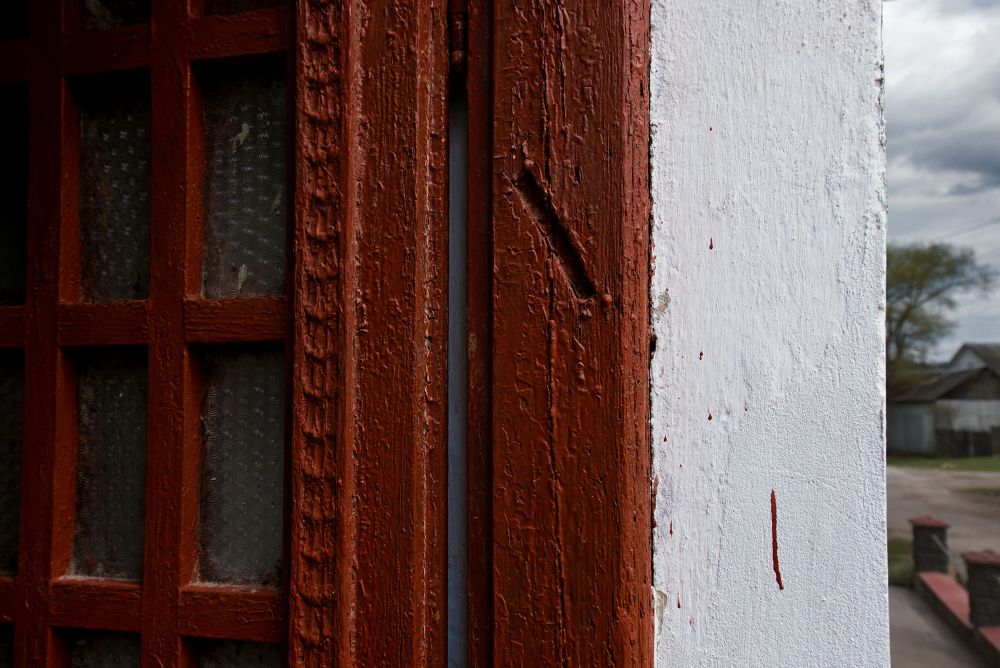 Pidhaitsi, Galicia, Ukraine, 207. Trace of a mezuzah. Photo: Christian Herrmann
Pidhaitsi, Galicia, Ukraine, 207. Trace of a mezuzah. Photo: Christian Herrmann
The laws that God gave to his people are attached to the doorpost. In secular Jewish households, the mezuzah is considered a home blessing. In fact, it is an ever-present reminder to obey the laws of God.
Finding a complete mezuzah is very rare. It has only happened to me twice. But its imprints on the door frames are not so rare. You just have to keep your eyes open when you walk through a former Jewish neighbourhood or stroll along the market square, where the Jewish shops used to be. However, these traces are in danger of disappearing. As people have money to carry out renovation works, they often replace the beautiful old doors with new plastic doors. This is called “evroremont” - renovation in European style. With the old doors, the traces of the mezuzot also disappear.
It’s shocking to see how most of the former Jewish sites and buildings on your photos are neglected or re-used without any awareness of its history. How do locals react when you confront them with this? Are there differences between countries in the way how they deal with Holocaust history?
Where there is continuity of memory, I don't have to confront anyone. On the contrary, it are the locals who confront me with their memories. When I take photographs, it happens often that old people come by and like to get in touch to share their memories or what was told in their families. They had to live with these memories all their lives and have rarely been listened to. During the years of the Soviet Union, the Holocaust was no topic, because the Soviets claimed the Jewish victims as "innocent Soviet citizens". The fact that they were not murdered because they were Soviet citizens, but because they were Jews, was not allowed to be discussed. Only with the implosion of the Soviet Union did it become possible to talk openly - but by then people already had other sorrows.
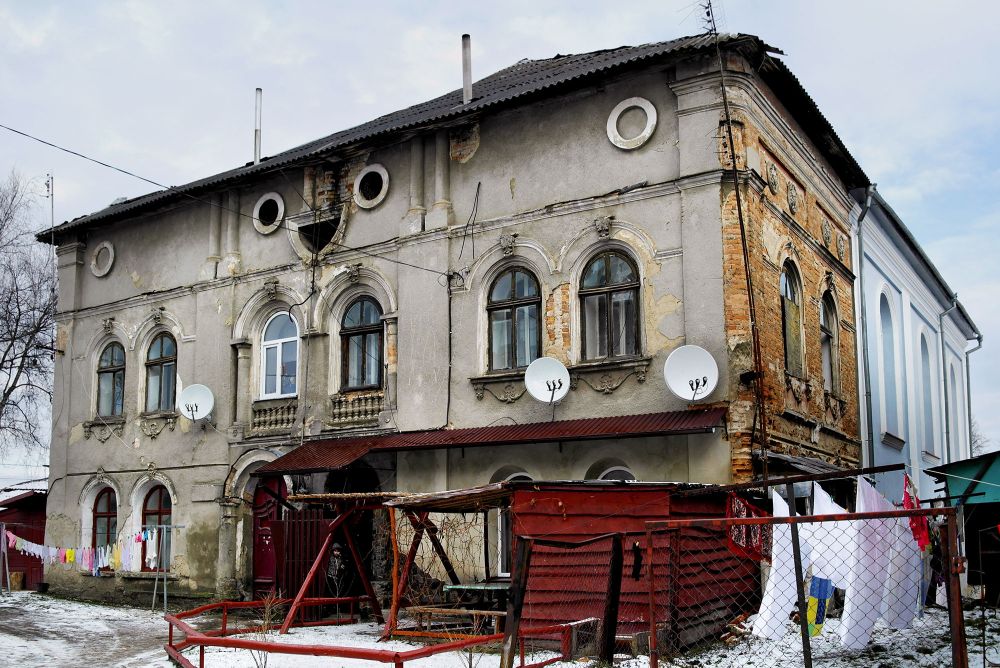
I would like to tell a story as an example. In February 2020 - shortly before the lockdown made further travel impossible - my friends and I were in the village of Hvizdets in Galicia, Ukraine. We were standing in front of an empty plot of land, which according to our GPS coordinates was supposed to be the Jewish cemetery. There was not a single gravestone to be seen. Whether the Nazis or the Soviets destroyed the cemetery, I cannot say. An elderly lady came by. We asked her if this had been the Jewish cemetery. "Yes," she said, "is that why you're here?" We nodded. "My mother told me what happened here," the old woman continued. "Here in the cemetery they shot the Jews, but also here in the middle of the street. My mother's family had Jewish neighbours. Chana, the neighbour's daughter, was my mother's best friend. They played together every day. She had a long black braid and everyone said she was the most beautiful girl in the village. Everyone said that. They shot Chana here too."
I have heard many such stories and we should stop talking about Ukrainians, Moldovans, Belarusians, Poles and Balts as anti-Semitic monsters. I think this is guilt reversal. I am not saying that there is no anti-Semitism in Eastern Europe, but we should be honest with ourselves. The Holocaust was planned and executed by Germans. They made half of Europe their accomplices in the process. Who in German, Dutch, Swedish or French families talks about "what grandpa did in Russia"? We should not be tempted to moral arrogance.
How is the Jewish heritage dealt with in Eastern Europe today? In many cases, this depends on integration into the European Union and is linked to the corresponding financial resources. Poland, Hungary, Romania and the Baltic states have restored many Jewish cultural monuments - partly with national, partly with European funds. In addition to financial resources, the ethical standards that Europe demands of its member states also play a role. Nevertheless, we are on a battlefield here. The Polish government is currently putting massive pressure on historians who do not like to follow the state-imposed culture of remembrance - according to which all Poles were saviours of Jews. Outside EU-Europe, we are also on complicated terrain, because here the lack of material resources and a nation building that is in motion overlap. Young people give me great hope. They approach history with open mind and curiosity. I am proud that some of them travelled with me and shared their knowledge.
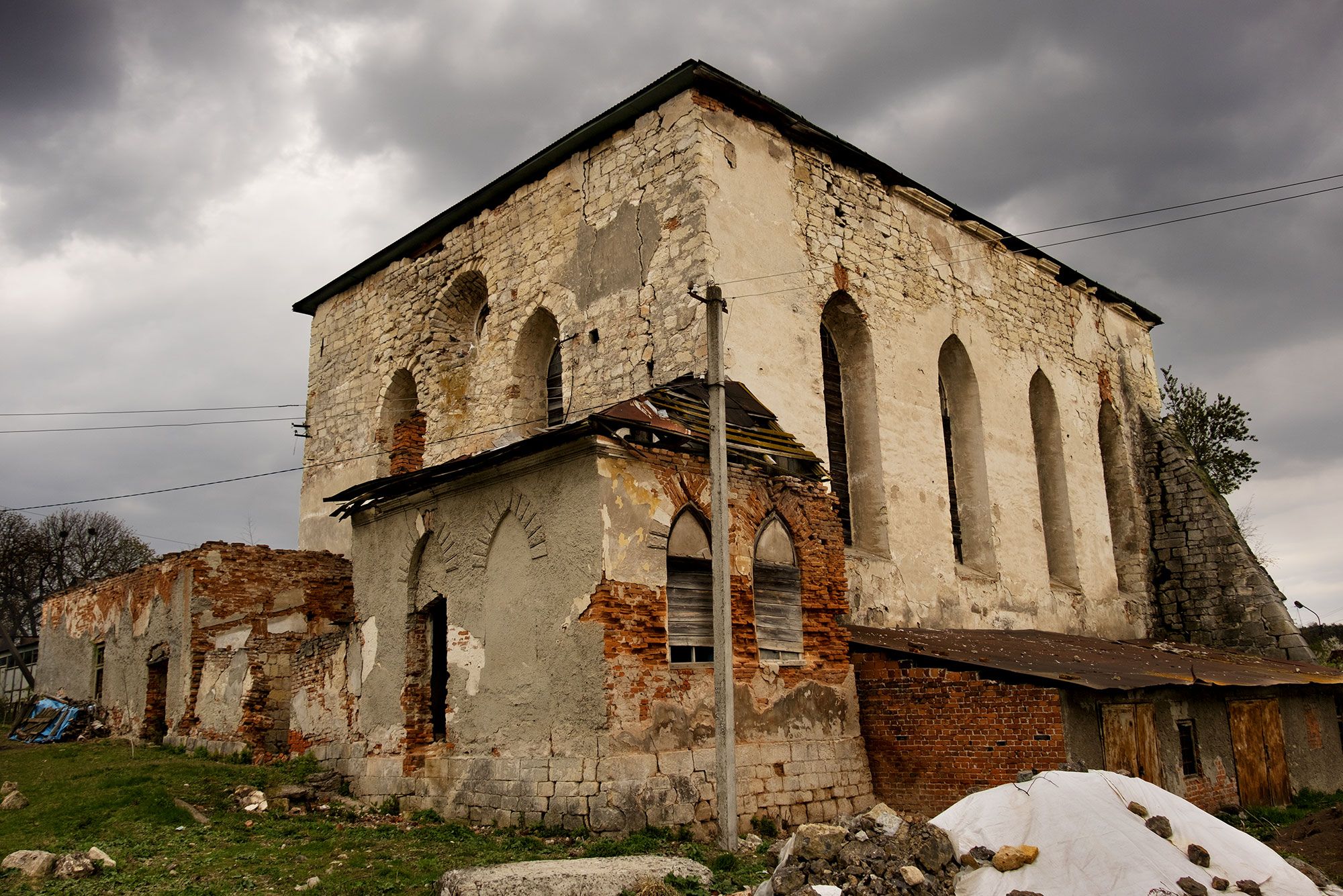 Pidhaitsi, Galicia, Ukraine, 2017. Ruin of the Great Synagogue. Photo: Christian Herrmann
Pidhaitsi, Galicia, Ukraine, 2017. Ruin of the Great Synagogue. Photo: Christian Herrmann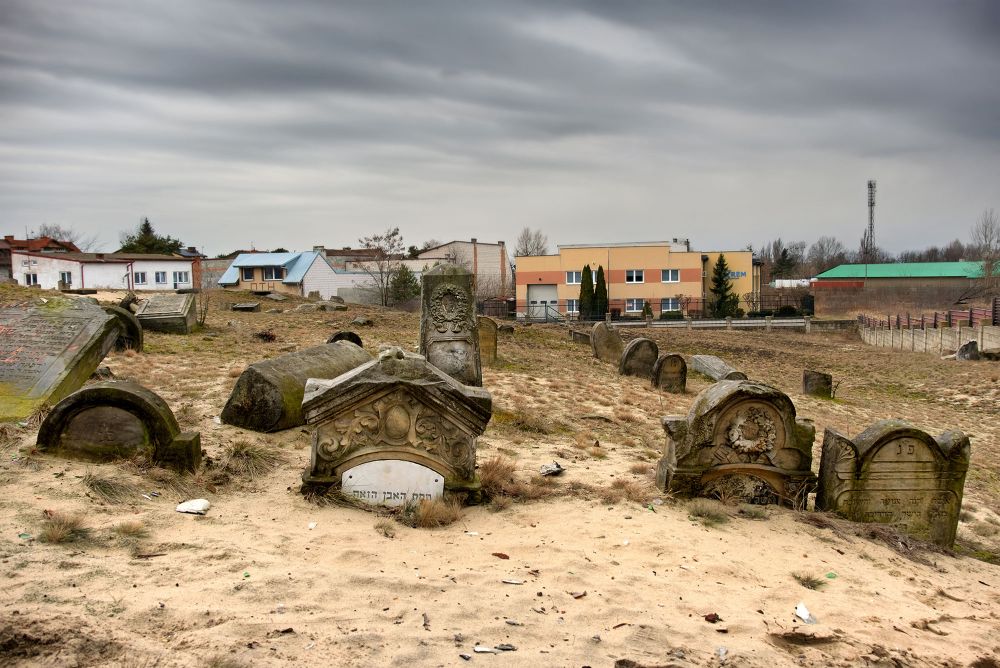 Karzcew, Masovia, Poland, 2017. Jewish cemetery. Photo: Christian Herrmann
Karzcew, Masovia, Poland, 2017. Jewish cemetery. Photo: Christian Herrmann
I would like to add a few words about the mentioned neglect and conversion of former Jewish buildings. I understand it when visitors are shocked to find a car repair workshop in a former synagogue. I too was shocked when I first came across such cases. The question is: What happens when the owner - usually the local municipality - terminates the contract with the tenant of the building? The former synagogue will rapidly deteriorate because there are neither the resources to maintain it nor a sensible concept for its future use. The fact is: the car repair workshop is saving the building - until a more dignified use is found. The neglect, moreover, is not exclusive to the Jewish heritage. A particularly sad example are the Catholic churches in western Ukraine, because there are no longer any Polish communities there. Another example are mansions where the Polish and Austrian nobility used to reside - they are also threatened by decay. As for the Ukrainian heritage: much of it has already disappeared, because the Soviets demolished many of the impressive wooden churches in the villages, for example.
Because of Covid you won’t have travelled much last year. Did you already plan new locations to visit and if so, where does your first trip go after the lockdown?
Yes, my last trip was in March 2020. Since then I've been in the home office and it pains me that I can't travel. That is, of course, a luxury problem. Ukraine in particular has been hit terribly by the pandemic. Many of my friends have been infected, one friend has died, others are still suffering from the late effects of Covid. A nice travel project would be the east and south of Belarus. I wish that Lukashenko's dictatorship will fall soon - then I could travel there again and be sure that my friends are well and safe there.
Sometimes I wake up at night because of intense dreams. In these dreams, I am standing on the balcony of my room in the Hotel George in Lviv, the historic capital of old Galicia in Ukraine. I look down on the hustle and bustle of people, sip a beer and look forward to the next day. Then my friend Vasyl will park his van in front of the hotel, more friends will jump in the car and we'll finally be back on the road. That's what I'm waiting for.
Translated by: Arnold W. Palthe
 Chortkiv, Galicia, Ukraine. Synagogue. Photo: Christian Herrmann
Chortkiv, Galicia, Ukraine. Synagogue. Photo: Christian HerrmannYour weblog Vanished World and your book 'In Fading Light' reveals you have visited a lot of locations and countries during the past ten years. When did you first encounter traces of lost Jewish life in Eastern Europe and why did you decide to document it by photography?
In the second half of the 1990s, I was invited to a summer academy near Krakow. I was blown away by the beauty of Krakow and wondered why Western Europeans did not travel to Eastern Europe - now that the borders were open. In Krakow, one inevitably stumbles upon the city's Jewish history. And that was my next question: Why don't I know anything about it? Since then, the topic of traces of Jewish life has been on my agenda. So I started travelling and taking photographs. At some point I realised that friends and colleagues were curious about what I found there. So I systematised my travels and made the pictures public. In fact, more people are interested in them than I originally thought.
How do you prepare your travels? Do you know beforehand where you want to go and take photos of or are often surprised?
That has changed a lot over the years. In the beginning, I looked for places where I assumed that something could be found there. There I had to ask around with the locals. That was not always easy, because these are often places where the population was almost completely replaced after the Holocaust and by forced resettlements after the Second World War. Young people often don't know that the local cinema was once a synagogue or that the city park was a Jewish cemetery.
Meanwhile, there are good sources on the internet and I can plan trips very precisely and know what I will find on the spot in advance. But because I also often travel with friends from the areas I explore, I am sometimes lucky enough to find traces that have not yet been documented. I benefit from their knowledge.
Most of the photos in your book seems to be taken during autumn or winter. This gives them a gloomy atmosphere, which is compatible with the sad subject of the photos. Is this on purpose and what are your feelings while visiting locations like deserted grave yards and ruins of synagogues? How do you make sure you don't get depressed?
Yes, my travel times are intentional. I travel in autumn, winter and spring - not in summer. I don't like my pictures to look like it's time to go to the beach now.
Not every place is depressing. There are very beautiful cemeteries. You can sit there, listen to the birds and feel the passing of time. I feel then that there is something bigger than us individual human beings. I don't have a name for it, but it is something that teaches us humility. And that can be a very beautiful experience. I think everyone knows the feeling of lying on your back at night and looking up at the starry sky. It's a very similar experience.
Of course, many places are just depressing and leave me with abysmal sadness. It is therefore important for me to travel with friends who share my interests and with whom I can talk about the daily experiences in the evening. The people who follow my travels online are also a great support. Often they were born where I am photographing, or their families originate from there. They share their memories or those of their families and I can give them something by showing them what it looks like there today. These contacts are very important to me.
The title of your blog is a tribute to photography pioneer Roman Vishniac. Could you tell us who he was and why does he inspire you?
Roman Vishniac was a giant, I really don't want to compare myself to him. He was one of the last to photograph Jewish life from Berlin to Galicia - before it was destroyed by the Germans and their helpers. Of course, he could not have known this in the second half of the 1930s, at best he could have suspected or feared it. He was not the only photographer to whom we owe pictures from that time, but he was perhaps the most talented and he had a feeling for people. His portraits are unique. Like him, we live in a time of upheaval, things change quickly and some disappear irretrievably. I photographed a former Jewish study house in Burschtyn in Ukraine several times. It has since been demolished. Like this study house, traces disappear day by day. They are the traces of the people whose portraits Vishniac left us. That is the reason why my pictures are mostly deserted.
Of course, there are the other examples: Synagogues that have been restored and cemeteries that are maintained by local or international initiatives. I don't want to give the impression that everything will disappear, because that would not be true. But not everything will be saved either.
 Lviv, Galicia, Ukraine, 2015. Shop sign of an Jewish hatter. Photo: Christian Herrmann
Lviv, Galicia, Ukraine, 2015. Shop sign of an Jewish hatter. Photo: Christian HerrmannBelow the photos in your book is only a brief caption with the location and the date. “I have nothing to say. Just to show”, so you quote the German philosopher Walter Benjamin (1892-1940). Do you think the readers of your book will understand the historical meaning of your photos without knowing the underlying facts?
There is a reason why I asked my friend Adam Kerpel-Fronius to write a foreword. He is a historian and works at the Memorial to the Murdered Jews of Europe in Berlin. Of course, the images need a historical context. The image of an empty field remains the image of an empty field as long as you don't know that there is a mass grave underneath. What I wanted to say with the quote is this: Memory and commemoration is something very personal and I don't want to tell people what to think and feel. The reactions to my pictures are diverse: anger, sadness, disgust, shock, joy that there are still traces. A lot of it is very emotional. Some people don't want to see the pictures because it reminds them of how and where their relatives were murdered. All these reactions have their reasons and it is not for me to judge which feelings are right or wrong. There is no right or wrong here.
I also hope that my pictures contribute to what and how we remember. Almost always, when something about the Holocaust is published in a newspaper or an online magazine, the editors choose the same motif to illustrate it: the tracks leading through the gate of Auschwitz-Birkenau into the camp. Anyone who has ever been there has certainly seen the many people who photograph this motif themselves. They replicate the image that is already in their head. Our world of images is becoming impoverished and with it our knowledge about the Holocaust. Of course, we must remember what happened in Auschwitz. However, most of the victims never saw a camp from the inside. They were shot in pits, ditches or quarries in the immediate vicinity of their homes, or they were taken to places that are poorly described by the term camp, because they were pure killing facilities. Most people have never heard of these place but they are essential for a comprehensive understanding of the Holocaust. We need other and more images in the collective memory so that our knowledge does not become impoverished.
In your book there are different photos of the remains of so called mezuzot. Could you explain what was the purpose of this Jewish religious custom? Are these traces difficult to find?
What is a mezuzah? It is a small tubular container in which is a handwritten parchment that is mounted on the door frame. The text on the parchment consists of verses from the Torah: the prayer Shema Yisrael, beginning with the phrase “Hear, O Israel, the Lord is our God, the Lord is One”.
This prayer includes also an explanation for the mezuzah. It reads: “And these words, which I command thee this day, shall be upon thy heart; and thou shalt teach them diligently unto thy children, and shalt talk of them when thou sittest in thy house, and when thou walkest by the way, and when thou liest down, and when thou risest up. And thou shalt bind them for a sign upon thy hand, and they shall be for frontlets between thine eyes. And thou shalt write them upon the door-posts of thy house, and upon thy gates.”
 Pidhaitsi, Galicia, Ukraine, 207. Trace of a mezuzah. Photo: Christian Herrmann
Pidhaitsi, Galicia, Ukraine, 207. Trace of a mezuzah. Photo: Christian HerrmannThe laws that God gave to his people are attached to the doorpost. In secular Jewish households, the mezuzah is considered a home blessing. In fact, it is an ever-present reminder to obey the laws of God.
Finding a complete mezuzah is very rare. It has only happened to me twice. But its imprints on the door frames are not so rare. You just have to keep your eyes open when you walk through a former Jewish neighbourhood or stroll along the market square, where the Jewish shops used to be. However, these traces are in danger of disappearing. As people have money to carry out renovation works, they often replace the beautiful old doors with new plastic doors. This is called “evroremont” - renovation in European style. With the old doors, the traces of the mezuzot also disappear.
It’s shocking to see how most of the former Jewish sites and buildings on your photos are neglected or re-used without any awareness of its history. How do locals react when you confront them with this? Are there differences between countries in the way how they deal with Holocaust history?
Where there is continuity of memory, I don't have to confront anyone. On the contrary, it are the locals who confront me with their memories. When I take photographs, it happens often that old people come by and like to get in touch to share their memories or what was told in their families. They had to live with these memories all their lives and have rarely been listened to. During the years of the Soviet Union, the Holocaust was no topic, because the Soviets claimed the Jewish victims as "innocent Soviet citizens". The fact that they were not murdered because they were Soviet citizens, but because they were Jews, was not allowed to be discussed. Only with the implosion of the Soviet Union did it become possible to talk openly - but by then people already had other sorrows.

I would like to tell a story as an example. In February 2020 - shortly before the lockdown made further travel impossible - my friends and I were in the village of Hvizdets in Galicia, Ukraine. We were standing in front of an empty plot of land, which according to our GPS coordinates was supposed to be the Jewish cemetery. There was not a single gravestone to be seen. Whether the Nazis or the Soviets destroyed the cemetery, I cannot say. An elderly lady came by. We asked her if this had been the Jewish cemetery. "Yes," she said, "is that why you're here?" We nodded. "My mother told me what happened here," the old woman continued. "Here in the cemetery they shot the Jews, but also here in the middle of the street. My mother's family had Jewish neighbours. Chana, the neighbour's daughter, was my mother's best friend. They played together every day. She had a long black braid and everyone said she was the most beautiful girl in the village. Everyone said that. They shot Chana here too."
I have heard many such stories and we should stop talking about Ukrainians, Moldovans, Belarusians, Poles and Balts as anti-Semitic monsters. I think this is guilt reversal. I am not saying that there is no anti-Semitism in Eastern Europe, but we should be honest with ourselves. The Holocaust was planned and executed by Germans. They made half of Europe their accomplices in the process. Who in German, Dutch, Swedish or French families talks about "what grandpa did in Russia"? We should not be tempted to moral arrogance.
How is the Jewish heritage dealt with in Eastern Europe today? In many cases, this depends on integration into the European Union and is linked to the corresponding financial resources. Poland, Hungary, Romania and the Baltic states have restored many Jewish cultural monuments - partly with national, partly with European funds. In addition to financial resources, the ethical standards that Europe demands of its member states also play a role. Nevertheless, we are on a battlefield here. The Polish government is currently putting massive pressure on historians who do not like to follow the state-imposed culture of remembrance - according to which all Poles were saviours of Jews. Outside EU-Europe, we are also on complicated terrain, because here the lack of material resources and a nation building that is in motion overlap. Young people give me great hope. They approach history with open mind and curiosity. I am proud that some of them travelled with me and shared their knowledge.
 Pidhaitsi, Galicia, Ukraine, 2017. Ruin of the Great Synagogue. Photo: Christian Herrmann
Pidhaitsi, Galicia, Ukraine, 2017. Ruin of the Great Synagogue. Photo: Christian Herrmann Karzcew, Masovia, Poland, 2017. Jewish cemetery. Photo: Christian Herrmann
Karzcew, Masovia, Poland, 2017. Jewish cemetery. Photo: Christian HerrmannI would like to add a few words about the mentioned neglect and conversion of former Jewish buildings. I understand it when visitors are shocked to find a car repair workshop in a former synagogue. I too was shocked when I first came across such cases. The question is: What happens when the owner - usually the local municipality - terminates the contract with the tenant of the building? The former synagogue will rapidly deteriorate because there are neither the resources to maintain it nor a sensible concept for its future use. The fact is: the car repair workshop is saving the building - until a more dignified use is found. The neglect, moreover, is not exclusive to the Jewish heritage. A particularly sad example are the Catholic churches in western Ukraine, because there are no longer any Polish communities there. Another example are mansions where the Polish and Austrian nobility used to reside - they are also threatened by decay. As for the Ukrainian heritage: much of it has already disappeared, because the Soviets demolished many of the impressive wooden churches in the villages, for example.
Because of Covid you won’t have travelled much last year. Did you already plan new locations to visit and if so, where does your first trip go after the lockdown?
Yes, my last trip was in March 2020. Since then I've been in the home office and it pains me that I can't travel. That is, of course, a luxury problem. Ukraine in particular has been hit terribly by the pandemic. Many of my friends have been infected, one friend has died, others are still suffering from the late effects of Covid. A nice travel project would be the east and south of Belarus. I wish that Lukashenko's dictatorship will fall soon - then I could travel there again and be sure that my friends are well and safe there.
Sometimes I wake up at night because of intense dreams. In these dreams, I am standing on the balcony of my room in the Hotel George in Lviv, the historic capital of old Galicia in Ukraine. I look down on the hustle and bustle of people, sip a beer and look forward to the next day. Then my friend Vasyl will park his van in front of the hotel, more friends will jump in the car and we'll finally be back on the road. That's what I'm waiting for.
Translated by: Arnold W. Palthe
Used source(s)
- Source: Christian Herrmann / TracesOfWar
- Published on: 26-02-2021 18:42:37
Latest news
- 28-03: Black pilots had to fight for every step forward
- 25-03: Band of Brothers actors to parachute into Normandy for D-Day
- 02-03: 4,500 crashes in Scotland on more than 700 pages
- 01-03: Kolberg, 1945: Evacuation from a besieged city
- 25-02: G.I. Stories 1941-1945 wants to bring the story of the American soldier to a larger audience
- 28-01: Order a book at Pen & Sword Books and support us
- 27-01: Hitler's last propaganda film premiered 79 years ago
- 06-01: Mike Sadler, desert navigator who guided WWII commandos, dies at 103
- 12-'23: Merry Christmas and a prosperous 2024
- 09-'23: The German Ostheer became bogged down in a war of attrition it could never win


